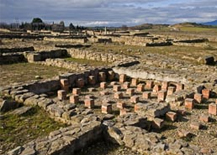
The ruins of the Roman city of Andelos emerge from the earth. It is a silent site that reflects the past prosperity of the Roman Empire. Its streets and houses, shops, thermal baths and foundations, beliefs and traditions bring the memory of the past alive again. The history of this city leaves us an extraordinary legacy of civil engineering in a good state of conservation: the city’s water supply system. The Roman city of Andelos is located in the municipality of Mendigorría, in the Central Zone of Navarre. It stands high up on a quaternary plateau on the right bank of the river Arga, just south of Puente la Reina.
The most notable discovery here is its water supply system. The state of conservation of this system is exceptional, and it includes the point where the water is taken to the distribution centre of the city. Apart from this finding, digging has revealed the layout of the streets and part of the old city walls.
Short history
On the site occupied by the Roman city of Andelos there was a human settlement that goes back to the 4th-3rd centuries B.C. It is possible that, from the 2nd century A.D. onwards, the first contacts between the Vascons and the Romans took place. The 1st and 2nd centuries A.D. were the period of the city’s greatest splendour. A major urban expansion took place at this time and the construction of the complex water supply system was carried out. The city remained inhabited until the Late Middle Ages; the chapel of Our Lady of Andión is the only element that still survives.
A walk through the city of Andelos
Access to the site is via the Archaeological Museum of Andelos, inaugurated in 2003. It is the starting point for discovering the mysteries of this 2,000-year-old city. There are sections explaining its origin, the first contacts with Roman civilisation, its architecture and way of life.
The visit starts in the street with arches. You can see the bases of the arches of the aqueduct that brought water from the reservoir to the city over a distance of 3.5 kilometres. Only these remains are conserved at present, vestiges of the long stone arm that supplied the city. From here, walking to the old laundry-dyeing shop and imagine yourself in an atmosphere full of aromas and colours.
At the end of the final section of the aqueduct you will see how it ended in the castellum aquae, where the distribution of water around the city began. This tank was used to distribute and divide the rate of flow. Then cross the ninfeo. The area around this fountain was surely a meeting point and discussion for the citizens of the city.
Crossing the city towards the northeast, continue the visit by standing at the start of the decumanus, one of the perpendicular axes crossed by the city. The first thing you will see on the right is the access to the house of the peristyle (arched courtyard with a well). Continue along the decumanus, enter the house of Bacchus and soak up the atmosphere of the god of wine.
The end of the decumanus links up with the cardus perpendicularly, which runs in a north-south direction. A good part of the social life of Andelos took part in this street, as it was a residential area with large houses and other buildings such as shops or the baths. These provided a very complete range of services, which were certainly not inferior to those of later centuries. There was a dressing room, a sauna, hot and cold baths, and also other ‘intermediate’ areas between these two. In the palestra, where the people did gymnastics and played games, the andelonenses cultivated their bodies and freed their minds.
Make sure you visit the water supply system 3.5 kilometres from Andelos, on the boundary between the municipalities of Mendigorría and Cirauqui. There is a reservoir with a capacity of 20,000 m3. You will be impressed by its excellent state of conservation and the 150-metres-long engineering work from the 1st century A.D. The next thing to see is the ‘regulating tank’, with capacity for 7,000 m3. It distributed water to the aqueduct, which then carried it to the city. Once there, it was distributed from the castellum aquae.







